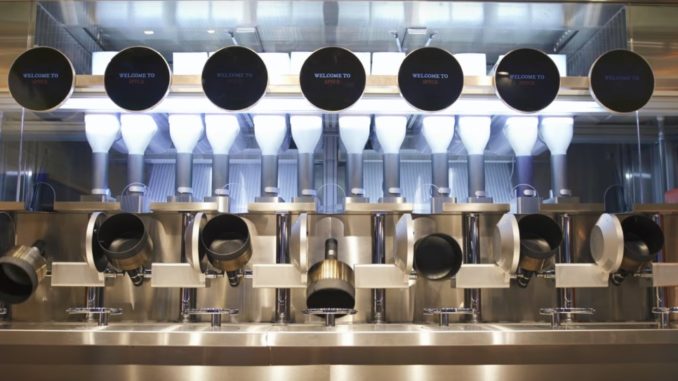
Almost all of the food at Spyce, a fast-casual restaurant which opened its doors in downtown Boston earlier this year, is prepared by robots. The robots must be doing a good job, as evidenced by the fact that Spyce just secured $21 million in Series A funding.
Touted as the world’s first robotic kitchen that cooks complex meals, the company has a storied beginning. The company is said to have been founded by four MIT mechanical engineering students with a keen interest in robotics in the basement of their fraternity in 2015. Applying their technology prowess to restaurant operations, the students developed a solution to automatically dispense ingredients onto a belt of rotating woks, cooking the meals using electromagnetic induction.
The concept presented a nice technology challenge and also addressed the need to meet a college student’s budgetary constraints for dining out, by enabling a restaurant to reduce traditional overhead to the point that healthy food options could be prepared and served at minimal cost. While specialized hardware and software doesn’t come cheap, Spyce has been successful in embracing technology to drive operational efficiencies that minimize costs, and customers are benefitting. Meals start at $7.50, which is slightly less than other bowl-based fast-casual restaurants, and with no guilt about not leaving a tip.
The fresh funding comes from investors that include Collaborative Fund, Maveron and Khosla Ventures. Several celebrity chefs, including Thomas Keller, Jérôme Bocuse, and Gavin Kaysen, also participated in the funding round. Michelin-star chef Daniel Boulud, who has served as the restaurant’s culinary director since the get-go, is also an investor. According to the reports, Spyce intends to use the funds to expand its market presence on the east coast with the opening of several new restaurants.
While the Boston location opened only in May of this year, the restaurant has won a big fan following due largely to technology innovation as well, of course, as the quality and prices of its food. Customers interact with technology from the moment they enter the restaurant, ordering their meals on a touch screen and then waiting as robot chefs cook and prepare it, with only minimal help from their human colleagues.
The restaurant features a variety of vegetable-focused dishes, many of them inspired by cuisine from India, Thailand, Morocco, and Latin America.

